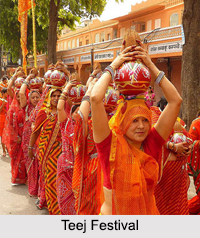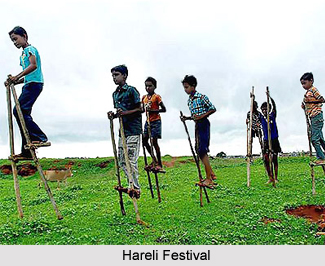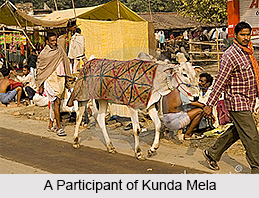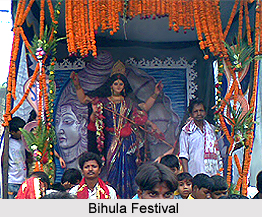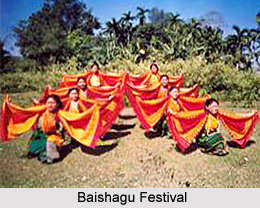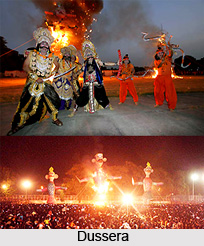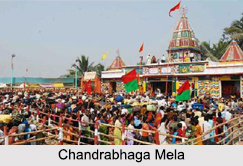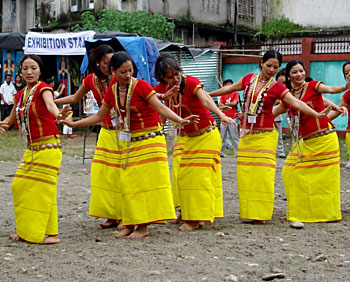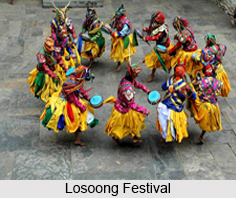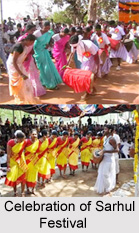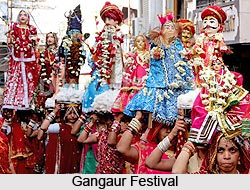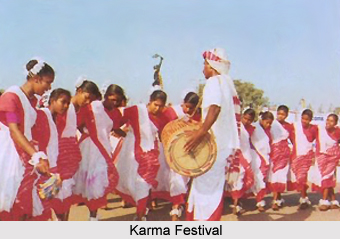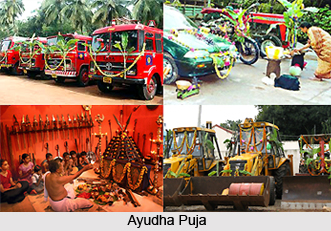 Durga Puja is celebrated in various ways during the autumn season in India. Whilst in east India Shakti is worshipped, in north and west India Navaratri is celebrated with much pomp and fanfare. Ayudha Puja or Astra Puja is also held during this time and its origin is essentially linked with the legends of Durga Puja. Ayudha Puja is mostly held in South India where it either takes place on Navami or Dashami. In Kerala, for instance, this festival is celebrated on Mahanavami but in the states of Tamil Nadu, Andhra Pradesh and Karnataka it is held on Vijaya Dashami. Ayudha Puja implies the worship of weapons. While the rest of India is busy in celebrating Navaratri or Vijaya Dashami, South India worships weapons and numerous tools on these auspicious days. Hence, their worship procedures also vary from that of Durga Puja in general.
Durga Puja is celebrated in various ways during the autumn season in India. Whilst in east India Shakti is worshipped, in north and west India Navaratri is celebrated with much pomp and fanfare. Ayudha Puja or Astra Puja is also held during this time and its origin is essentially linked with the legends of Durga Puja. Ayudha Puja is mostly held in South India where it either takes place on Navami or Dashami. In Kerala, for instance, this festival is celebrated on Mahanavami but in the states of Tamil Nadu, Andhra Pradesh and Karnataka it is held on Vijaya Dashami. Ayudha Puja implies the worship of weapons. While the rest of India is busy in celebrating Navaratri or Vijaya Dashami, South India worships weapons and numerous tools on these auspicious days. Hence, their worship procedures also vary from that of Durga Puja in general.
Regional names of Ayudha Puja
The festival of Ayudha Puja, known by various regional names, is celebrated with great reverence in different states of India. In Karnataka, which was formerly known as Mysore State, it is observed as "Ayudha Puje." Tamil Nadu refers to this festival as "Ayudha Pujai," while in the states of Telangana and Andhra Pradesh, it is known as "Aayudha Pooja." Kerala, on the other hand, calls it simply "Ayudha Puja." In Odisha, it goes by the names "Astra Puja" or "Ayudha Puja." Maharashtra has its version as "Shastra Puja" or "Ayudha Puja," which is also referred to as "Khande Navami." Interestingly, even within Karnataka, the festival is celebrated as "Ayudha Puje" due to its significance in the erstwhile Mysore State. Each of these regions honors the festival with distinct rituals and customs, reflecting the rich cultural diversity and traditions prevalent across India.
Religious Significance of Ayudha Puja
The occasion of Ayudha Puja holds profound religious significance as it venerates the triumphs of two revered figures in Hindu mythology. In one context, it commemorates the victory of the goddess Durga over the demon Mahishasura, symbolizing the triumph of good over evil. Another aspect of this occasion celebrates the conquest of Lanka by Lord Rama, signifying the triumph of righteousness over injustice.
In South India, Ayudha Puja takes on a special dedication to the goddess Saraswati, the embodiment of knowledge and learning. Here, the ritual involves the veneration of educational materials such as books, pens, pencils, musical instruments, and other equipment. This act symbolizes the victory of knowledge over ignorance and underscores the importance of education in one`s life.
In the region of Odisha, the ritualistic worship extends to tools used for cultivation, like the plough, as well as to weapons like swords and daggers, symbolizing the importance of both peaceful and protective endeavors. Additionally, inscription writing tools like "karani" or "lekhani" (metal stylus) are also given due reverence, acknowledging the significance of written communication and documentation.
Legends of Ayudha Puja
Most of the festivals celebrated in India have their roots in legends and Ayudha Puja is in no way different. According to legends after vanquishing Mahishasura, the weapons of Goddess Durga were worshipped by her devotees and thus, the tradition of weapon worship commenced. There is another legend that surrounds the celebration of Ayudha Puja. The traditions followed by the kings of Mysore in organising this puja trace its origin back to tales of Mahabharata.
Arjuna, one of the Pandava brothers, on this day retrieved his weapons from the Shami tree. He had hid his weaponry there as the Pandava brothers went into Agyatvash for a year. On the ninth day of Durga Puja, their Agyatvash ended and Arjuna aided King Virat in combating the Kauravas. On the day of Vijaya Dashami the Pandavas returned victorious by defeating the Kaurava army.
However, with passing time traditions have undergone changes. In fact, Ayudha Puja is celebrated today in form of tools and vehicle worship. This implies that people worship their tools that serve as livelihood. For instance, a carpenter or a mason worships his tools. With technological advancements, computers and other gadgets that are used for business purposes have become an integral part of Ayudha Puja.
Tradition of Ayudha Puja
Ayudha Puja is also similar to Vishwakarma Puja that is held in the states of Odisha, West Bengal, Assam, Tripura and other Eastern and Northern states. Lord Vishwakarma is hailed as the divine engineer and architect. On this day he is worshipped in all the industrial sectors, garages, shops, etc. However, in South India the mode of worship is a bit different. It is either Goddess Laxmi, Goddess Saraswati or Parvati who are worshipped besides Ayudha Puja. The principal goddesses worshipped during the Ayudha Puja are Saraswati, the goddess of learning, Lakshmi, the goddess of prosperity, and Parvati, the goddess of power.
Along with the idols or images of the goddesses, the weapons, vehicles, tools, musical instruments and others are also placed for worship. These devices are at first cleaned and then sandalwood paste and turmeric are smeared on them. They are bedecked with garlands and tilak. Even after the puja is over these are kept alongside the goddesses for that particular day.
 Ayudha Puja in different regions
Ayudha Puja in different regions
Ayudha Puja, also known as Shastra Puja or Saraswati Puja, is a significant festival celebrated in various regions of India with distinct customs and traditions. For instance, in Karnataka this religious festival is held according to the customs followed by the Mysore kings. On the other hand, in Tamil Nadu it is held on the eve of Navami. Here it is Saraswati, the goddess of knowledge, who is worshipped. In the recent times Ayudha Puja has become quite popular in the business houses as well. In Kerala too, Ayudha Puja is held in a similar fashion. The only difference is that here the festival is marked by various cultural programmes. Besides these south Indian states, Ayudha Puja is also an important religious event in the states of Maharashtra, Gujarat and Uttar Pradesh.
In Karnataka, Ayudha Puja has its origins in the Navaratri festival, which was initially observed as a family tradition within the confines of the Mysore palace during the reign of the Maharajas of Mysore. On the auspicious Mahanavami day (ninth day of Navaratri), the royal family performs rituals to venerate their weapons. Subsequently, the "Kushmanda" ceremony takes place, involving the breaking of a pumpkin within the palace grounds. The weapons are then carried in a golden palanquin to the Bhuvaneshwari temple for further veneration. This festival`s historical roots can be traced back to the Vijayanagara Empire where it evolved into a Naada Habba, or a people`s festival.
In Kerala, the festival is part of the ten-day puja ceremonies that align with the autumnal equinox. The veneration of implements occurs on two significant days. The opening day is known as "Pujaveppu," where implements are kept for veneration, and the closing day is called "Pujayeduppu," during which the implements are taken back from veneration.
Tamil Nadu celebrates the Navaratri period with a festival called "golu." The occasion involves the artistic arrangement of dolls, predominantly representing Hindu deities, on a seven-stepped wooden platform. Among the dolls, the `marapachi` wooden dolls symbolizing Perumal and Thayar hold a prominent place on the top step. On Navami day (ninth day), Saraswati Puja takes center stage, and special prayers are offered to the goddess Saraswati.
In Maharashtra, Ayudha Puja is observed with great fervor and is also known as Shastra Puja, Vijayadashami, Navaratri, and Saraswati Puja. This festival involves the worship of all types of weapons, vehicles, agricultural equipment, machines, and metal items. Worship is conducted using leaves of the shami tree and marigold flowers, along with the `dhaan` that is grown during the nine days of Navaratri. The Marigold flowers hold special significance on Navaratri day. Alongside the weaponry, people also worship books, musical instruments, and other tools, while Saraswati Puja is performed with devotion. An interesting ritual called "Simollanghan" is observed during this time, where people cross the boundaries of their villages to collect leaves of the apta tree, symbolizing prosperity and gold.
Ayudha Puja serves as a unifying celebration, bringing communities together to venerate their tools, implements, and weapons, while also expressing their devotion to the divine. As the festival continues to thrive and evolve in different regions, it remains an essential part of India`s vibrant culture, promoting unity and respect for craftsmanship across the country.
